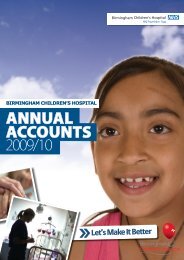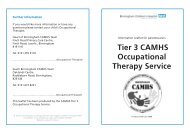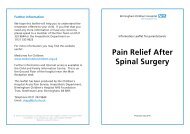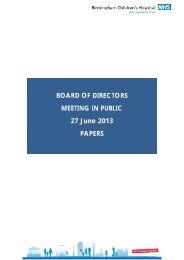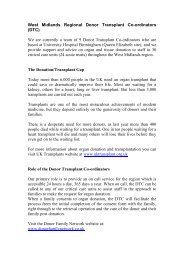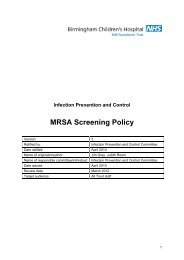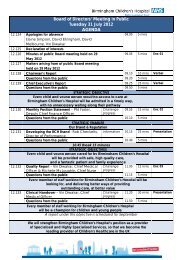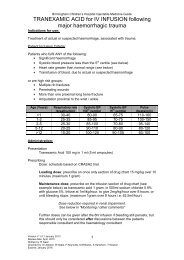Nurses Day! - Birmingham Children's Hospital
Nurses Day! - Birmingham Children's Hospital
Nurses Day! - Birmingham Children's Hospital
Create successful ePaper yourself
Turn your PDF publications into a flip-book with our unique Google optimized e-Paper software.
148 149<br />
BACK TO CONTENTS PAGE<br />
Major Risks<br />
Table 33: Major Organisational Risks<br />
Risk<br />
Failure to ensure the staff<br />
culture is aligned to the Trust’s<br />
strategic objectives could impact<br />
on achievement of the Trust’s<br />
strategic objectives and on the<br />
delivery of high quality care and<br />
patient experience.<br />
Planned reductions in funding<br />
could impact on the delivery<br />
of the Trust’s services, affect<br />
the quality of care and patient<br />
experience and impact on<br />
achievement of the Trust’s<br />
strategic objectives.<br />
Under developed workforce<br />
plans could impact on the<br />
delivery of the Trust’s services,<br />
affect the quality of care and<br />
patient experience and impact<br />
on achievement of the Trust’s<br />
strategic objectives.<br />
Failure to deliver our Cost<br />
Improvement Plans could<br />
impact on the delivery of the<br />
Trust’s services, affect the<br />
quality of care and patient<br />
experience and impact on<br />
achievement of the Trust’s<br />
strategic objectives.<br />
A delay in delivery of the<br />
strategic outline case for the<br />
new hospital project could<br />
impact on achievement of the<br />
Trust’s strategic objectives.<br />
Management & Mitigation<br />
l Seek feedback from staff through a range of means and embed<br />
the output and associated actions into Trust reporting systems<br />
l Embed results from local surveys and staff polls into performance<br />
indicators and leadership appraisals with a goal of 10%<br />
improvement each year<br />
l Develop a cultural barometer for use across all parts of the<br />
organisation<br />
l Improve the regularity and quality of staff briefing<br />
l Work with the <strong>Birmingham</strong> Director of Public Health to develop a<br />
health impact assessment of proposed funding changes<br />
l Engage with staff, patients and families on the potential solutions<br />
to reduction in resources<br />
l Identify and develop alternative service scenarios that will better<br />
use public resources across the whole of the children’s mental<br />
health budget<br />
l Deliver improved workforce productivity through more efficient<br />
use of the temporary workforce and re-profiling of the total<br />
workforce<br />
l Shift from junior medics to advanced practitioners<br />
l Shift in WTE from nurses to support workers<br />
l Review the medical administration function<br />
l Improve experience and quality of clinical education placements<br />
for all clinical staff<br />
l Improvement in students and juniors recommending BCH as a<br />
place to train by 10%<br />
l Set a financial plan for 2013/14 that requires an achievable<br />
CIP target<br />
l Review legacy CIPs carried forward from 2012/13<br />
l Strengthen PMO function and its monitoring mechanisms<br />
l Revise focus on CIP at performance reviews<br />
l Enhance the CIP Governance framework especially with regards<br />
to Quality Impact Assessments<br />
l Regular formal engagement with key stakeholders<br />
l Board level review of progress and barriers to moving the project<br />
forward<br />
l Programme board with key partners re-established<br />
l Project infrastructure of key partners being established<br />
l Development of detailed plan with key milestones<br />
During 2012/13 some internal control issues<br />
emerged relating to the management of junior<br />
doctor rotas. These issues created risks in relation<br />
to the Trust’s ability to demonstrate full compliance<br />
with the Working Time Regulations and the New<br />
Deal arrangements. The issues also created<br />
financial risks. A detailed risk analysis provided<br />
assurance that the risk to patient safety was low.<br />
Management of these risks and the processes<br />
put in place to address the internal control issues<br />
were closely monitored by the Board of Directors<br />
and its committees, including the Audit Committee.<br />
Support and leadership was provided by Executive<br />
and Non-Executive Directors.<br />
A review by the West Midlands Deanery in March<br />
2013 provided assurance on the quality of the new<br />
processes and systems. An independent review<br />
has been commissioned by the Audit Committee to<br />
provide additional assurance that these processes<br />
and systems are embedded and sustainable.<br />
The Board of Directors is satisfied that the actions<br />
taken have addressed the internal control issues.<br />
Review of economy, efficiency and<br />
effectiveness of the use of resources<br />
The Trust has a range of processes embedded<br />
throughout the organisation to ensure that<br />
resources are used economically, efficiently and<br />
effectively.<br />
In reviewing the key risks of the organisation<br />
through the Board Assurance Framework the<br />
Board considers the effectiveness of the internal<br />
controls compared with the risks. On a regular<br />
basis it also reviews progress against the annual<br />
service plans and the financial plan that results<br />
from this. The Board is supported in the process<br />
by a regular, in-depth review by the Finance and<br />
Resources Committee of the Trust’s financial<br />
position, business cases for significant revenue<br />
and capital investments, and the investment of<br />
cash balances.<br />
Table 34: Internal Audit limited assurance opinion<br />
Clinical Coding: Outpatient &<br />
Emergency<br />
The review found weaknesses<br />
in the coding processes,<br />
including validation and audit.<br />
The Audit Committee supports the delivery of<br />
effective, efficient and economic services through:<br />
l Undertaking a range of thematic reviews,<br />
including workforce, financial standing,<br />
arrangements to deliver quality services and the<br />
effectiveness of the assurance process.<br />
l Considering the coverage of external<br />
and internal audit and reviewing progress<br />
on implementing internal and external audit<br />
recommendations.<br />
The Trust uses a comprehensive internal audit<br />
service as part of its assurance process. An annual<br />
internal audit work programme is risk based and<br />
progress and amendments are reported to the<br />
Audit Committee.<br />
A new Internal Auditor was appointed in 2012/13,<br />
which provided the opportunity for a fresh, in depth<br />
review of the Trust’s risk and quality governance<br />
processes. Significant assurance was given in the<br />
following reviews:<br />
1. Board Assurance Framework<br />
2. Risk Management<br />
3. CQC compliance<br />
4. CAS alerts<br />
5. Clinical Audit<br />
6. SIRI process<br />
7. Quality Governance<br />
8. Directorate Governance<br />
The Internal Auditor gave limited assurance as<br />
follows in table 34 below.<br />
Review Control weakness Action<br />
Programme of formal audit<br />
and regular spot checks to<br />
be established. Longer-term<br />
adoption of automated process.




